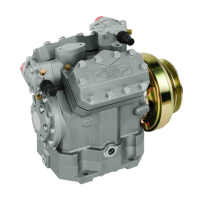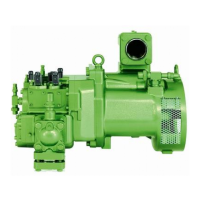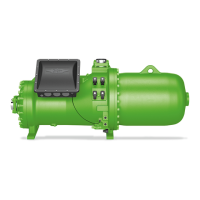14 KB-570-1 RUS
ST-130-2
2
2 Functions
The OLC-D1-S can monitor either the
minimum or the maximum oil level,
depending on its mounting position
and incorporation into the safety
chain. If the minimum and the maxi-
mum oil level should be monitored,
two OLC-D1-S devices must be
installed.
2.1 Monitoring of the minimum
level
Lock out
The compressor is shut off, if the
prism sticks out of the oil longer than
the delay time specified by the circuit.
The OLC-D1-S then opens the output
contact and the circuit locks out elec-
tronically: The control voltage to the
compressor contactor is interrupted.
The red LED at the face side of the
opto-electronic unit lights up (figure 1)
as well as the signal lamp H4.
Reset
The circuit can be manually reset by
pressing the reset button. This reset
button (S4) has to be mounted into
the swich board. (Connection see
sche matic wiring diagram.)
2 Fonctionnement
Le OLC-D1-S peut contrôler soit le
niveau d'huile minimal soit le niveau
d'huile maximal, dépendant de la position
de montage et de l'intégration dans la
chaîne de sécurité. Pour surveiller le
niveau d'huile minimal et maximal en
même temps, deux OLC-D1-S doivent
être installés.
2.1 Contrôle du niveau d'huile minimal
Verrouiller
Le compresseur est arrêté des lors que le
temps pendant lequel le cône de verre
dépasse le niveau d'huile est supérieur à
la la temporisation prédéfinie par le
réglage.
Le OLC-D1-S ouvre alors le contact de
sortie et le circuit se verrouille électroni-
quement: la tension de commande du
con tacteur du compresseur est alors
coupée. La LED rouge sur le côté frontal
de l'unité opto-électronique s'allume (figu-
re 1) et ainsi que la lampe H4.
Déverrouiller
Le circuit peut être remis manuellement
en fonctionnement par la touche de reset.
Cette touche (S4) devra être montée
dans l'armoire électrique. (Raccordement
voir schéma de principe.)
2 Funktionen
Das OLC-D1-S kann entweder das
mini male oder das maximale Ölnive au
über wachen, je nach Montage-Posi ti -
on und Einbettung in die Sicher heits -
kette. Falls sowohl das mini male wie
das maximale Ölnive au über wacht
werden soll, müssen zwei OLC-D1-S
installiert werden.
2.1 Minimale Ölniveau-Überwa-
chung
Verriegeln
Der Verdichter wird abgeschaltet,
wenn der Glas-Kegel länger als die
durch die Schaltung vorgegebene Ver -
zöge rungs zeit aus dem Öl herausragt.
Das OLC-D1-S öffnet dann den Aus -
gangs kon takt und die Schaltung ver-
riegelt elektronisch: Die Steuerspan -
nung zum Verdich ter schütz wird unter-
brochen. Die rote LED auf der Stirn -
seite der opto-elektronischen Ein heit
(Abb. 1) und die Signallampe H4
leuchten.
Entriegeln
Die Schaltung kann über eine Reset-
Taste manuell zurück gesetzt werden.
Diese Reset-Taste (S4) muss im
Schalt schrank montiert werden.
(Anschluss siehe Prinzipschaltbild.)
Abb. 1 Abmessungen und Aufbau Fig. 1 Dimensions and design
Fig. 1 Dimensions et construction
1 Prisma-Einheit
2 Glas-Kegel
3 Dichtung
4 Opto-elektronische Einheit "OLC-D1"
(360° drehbar)
5 Anschlusskabel
6 Schraubkappe
1 Prism unit
2 Glass cone
3 Gasket
4 Opto-electronic unit "OLC-D1"
(360° revolving)
5 Connecting cable
6 Screwing cap
1 Unité prisme
2 Cône en verre
3 Joint
4 Composant opto-électronique "OLC-D1"
(mobile sur 360°)
5 Câble de raccordement
6 Chapeau à visser
Gefahr!
Prüfdruck des Verdichters darf
die auf dem Typschild genannten
maximal zulässigen Drücke nicht
überschreiten!
Bei Bedarf Absperrventile
geschlossen halten!
5.2 Dichtheit prüfen
Kältekreislauf (Baugruppe) als Ganzes
oder in Teilen auf Dichtheit prüfen –
entsprechend EN 378-2 (oder gültigen
äquivalenten Sicherheitsnormen).
Dazu vorzugsweise mit getrocknetem
Stickstoff einen Überdruck erzeugen.
Gefahr!
Prüfdrücke und Sicherheits-
hinweise siehe Kapitel 5.1.
5.3 Evakuieren
Absperr- und Magnetventile öffnen.
Das gesamte System einschließlich
Verdichter auf Saug- und Hoch-
druckseite mit Vakuumpumpe evaku-
ieren.
Bei abgesperrter Pumpenleistung
muss ein „stehendes Vakuum“ (= kein
Druckanstieg innerhalb 2 Stunden)
kleiner als 1,5 mbar erreicht werden.
Wenn nötig Vorgang mehrfach wieder-
holen.
Achtung!
Mechanische Schäden möglich.
Verdichter nicht im Vakuum
starten!
Zuerst mit Kältemittel befüllen!
Danger!
Test pressure shall not exceed
the maximum operating
pressures indicated on the name
plate!
If necessary leave the shut-off
valves closed!
5.2 Tightness test
Evaluate tightness of the entire
refrigerant circuit (assembly) or parts
of it – according to EN 378-2 (or valid
equivalent safety standards) by using
preferably an overpressure of dry
nitrogen.
Danger!
Test pressures and safety
references see chapter 5.1.
5.3 Evacuation
Open shut-off valves and solenoid
valves. Evacuate the entire system
including compressor using a vacuum
pump connected to the high and low
pressure sides.
A “standing vacuum” (i. e. pressure
does not rise within two hours) less
than 1.5 mbar must be reached with
shut-off pump capacity.
If necessary repeat this procedure
several times.
Attention!
Mechanical damages possible.
Do not start compressor under
vacuum.
Charge refrigerant first!
Опасность!
Пробное давление не может
превышать максимальное рабочее
давление, указанное на заводской
табличке!
При необходимости держать
запорные клапаны закрытыми!
5.2 Испытание на плотность
Произведите проверку на герметичность
смонтированного холодильного контура
в целом или по частям в соответствии
с EN 378-2 (или другим действующим
стандартом безопасности), желательно
используя сухой азот.
Опасность!
Методика проведения испытаний
давлением и указания по
безопасности указаны в главе 5.1.
5.3 Вакуумирование
Открыть запорные клапаны и электро-
магнитные клапаны. Свакуумировать всю
систему, включая компрессор, с помощью
вакуумного насоса соединенного со
сторонами высокого и низкого давления.
«Остаточный вакуум» (т. е. давление
не поднимается в течение двух часов)
должен сохраняться равным меньше, чем
1,5 мбар при выключенном насосе. При
необходимости повторите эту процедуру
несколько раз.
Внимание!
Возможны механические
повреждения.
Не запускайте компрессор под
вакуумом.
Сначала заправьте хладагент!

